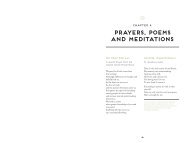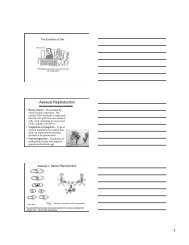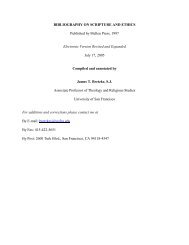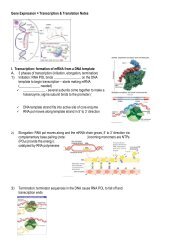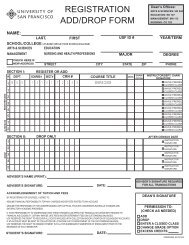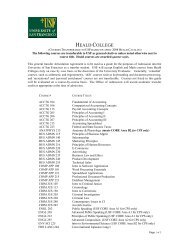Extensions of Mendel
Extensions of Mendel
Extensions of Mendel
Create successful ePaper yourself
Turn your PDF publications into a flip-book with our unique Google optimized e-Paper software.
non-<strong>Mendel</strong>ian geneic<br />
interactions<br />
I. Interactions between the alleles <strong>of</strong> one<br />
gene<br />
A. Incomplete Dominance<br />
B. Multiple alleles<br />
C. Codominance<br />
D. Lethal alleles<br />
II.<br />
Interactions between the alleles <strong>of</strong> more<br />
than one gene<br />
A. Gene interaction<br />
B. Epistasis<br />
I. Interactions between the alleles<br />
<strong>of</strong> one gene<br />
A. Incomplete Dominance<br />
Two alleles (heterozygote) produce an intermediate<br />
phenotype<br />
Wildtype v. Mutant<br />
Symbols for alleles<br />
• At the molecular level, the mutant allele results in a<br />
reduced amount <strong>of</strong> functional protein<br />
– 2 doses =<br />
– 1 dose =<br />
– 0 dose =<br />
1
incomplete dominance<br />
•F 1 hybrids have an<br />
appearance somewhere in<br />
between the phenotypes<br />
<strong>of</strong> the two parental<br />
varieties<br />
• F 1 is pink, an<br />
intermediate color<br />
between white and red, F 2<br />
1:2:1<br />
Example: Tay-Sachs disease – Homozygous recessive<br />
individuals are severely affected (death by age 3),<br />
Heterozygotes express only about 50% <strong>of</strong> hexosaminidase<br />
enzyme for lipid metabolism. Slightly affected.<br />
The closer we look, the more we find that heterozygotes are<br />
different from homozygous dominant individuals.<br />
2
Example question:<br />
Palomino horses have golden yellow coats, chestnut horses have a brown<br />
coat, and cremello horses have a coat that is almost white. A series <strong>of</strong><br />
crosses between the three different type <strong>of</strong> horses produce the following<br />
<strong>of</strong>fspring:<br />
Cross<br />
Palomino x Palomino<br />
<strong>of</strong>fspring<br />
13 palomino, 6 chestnut, 5 cremello<br />
Chestnut x Chestnut<br />
16 chestnut<br />
Cremello x Cremello<br />
Palomino x Chestnut<br />
Palomino x Cremello<br />
Chestnut x Cremello<br />
13 cremello<br />
8 palomino, 9 chestnut<br />
11 palomino, 11 cremello<br />
23 palomino<br />
Explain the inheritance <strong>of</strong> the three phenotypes, list the genotypes <strong>of</strong> all the<br />
parents and <strong>of</strong>fspring<br />
B. Multiple<br />
alleles<br />
• Some genes are<br />
found in three or<br />
more alleles that<br />
are different from<br />
each other<br />
e.g. white clover,<br />
coat color in rabbits<br />
3
Example:<br />
C = full coat color; dominant to all other alleles<br />
cch = chinchilla coat, a partial defect in pigmentation;<br />
dominant to ch and c<br />
ch = himalayan coat, color in only certain parts <strong>of</strong> body;<br />
dominant to c<br />
c = albino, no color; recessive to all other alleles<br />
A rabbit with chinchilla fur is mated to a himalayan. Some <strong>of</strong> their<br />
F 1 <strong>of</strong>fspring have himalyan fur, some have chinchilla fur and some<br />
are albino. Name the genotypes <strong>of</strong> the parents and the genotypic<br />
ratios <strong>of</strong> the F 1 <strong>of</strong>fspring.<br />
Codominance<br />
Genotype<br />
Blood Type<br />
Specific type <strong>of</strong> multiple<br />
alleles, when two alleles<br />
I A /I A or I A /i<br />
I B /I B or I B /i<br />
I A /I B<br />
i/i<br />
A<br />
B<br />
AB<br />
O<br />
4
Example:<br />
The LM and LN alleles at the MN blood group locus exhibit codominance.<br />
Give the expected genotypes and phenotypes and their ratios in progeny<br />
resulting from the following crosses:<br />
a. L M L M x L M L N<br />
b. L N L N x L N L N<br />
c. L M L N x L M L N<br />
d. L M L N x L N L N<br />
5
Allele in an essential gene<br />
that has the potential <strong>of</strong><br />
causing the death <strong>of</strong> an<br />
organism.<br />
loss <strong>of</strong> function mutation<br />
tolerated in heterozygote, but<br />
recessive lethal allele in the<br />
homozygous state<br />
– Age <strong>of</strong> onset<br />
– Conditional lethal alleles<br />
– Semilethal alleles<br />
C. Lethal alleles<br />
6
II. Interactions between the alleles <strong>of</strong><br />
more than one gene<br />
Genes interact in concert with other<br />
genes and with the environment to<br />
influence a particular characteristic.<br />
Final product<br />
Interactions between genes produce<br />
many different phenotypes<br />
Examples: morphological<br />
characteristics - Height, weight,<br />
growth rate, pigmentation<br />
7
One trait, involving between two genes<br />
• Bateson & Punnett 1906 studied comb<br />
morphology in chickens –<br />
RP<br />
Rp<br />
rP<br />
rp<br />
RP<br />
RRPP<br />
RRPp<br />
RrPP<br />
RrPp<br />
Rp<br />
RRPp<br />
RRpp<br />
RrPp<br />
Rrpp<br />
rP<br />
RrPP<br />
RrPp<br />
rrPP<br />
rrPp<br />
rp<br />
RrPp<br />
Rrpp<br />
rrPp<br />
rrpp<br />
8
9:3:3:1 with four different phenotypes <br />
•R-P- (walnut), R-pp (rose), rrP- (pea), rrpp (single)<br />
A. Epistatic interactions<br />
Expression <strong>of</strong> one gene or gene pair masks or<br />
modifies the expression <strong>of</strong> another gene or gene pair<br />
Epistatic = gene product that masks another gene. Hypostatic = the second gene<br />
product being masked by another gene.<br />
Often arise because two or more different proteins participate in<br />
an enzymatic pathway leading to the formation <strong>of</strong> a single<br />
product.<br />
Enzyme C needed to convert the precursor into the intermediate,<br />
Enzyme P converts the colorless intermediate into purple pigment<br />
9
•Sweet Peas – flower color<br />
P: White x White<br />
F 1 :<br />
F 2 :<br />
CP<br />
Cp<br />
cP<br />
cp<br />
CP<br />
CCPP<br />
CCPp<br />
CcPP<br />
CcPp<br />
Cp<br />
CCPp<br />
CCpp<br />
CcPp<br />
Ccpp<br />
cP<br />
CcPP<br />
CcPp<br />
ccPP<br />
ccPp<br />
cp<br />
CcPp<br />
Ccpp<br />
ccPp<br />
ccpp<br />
C-P- (purple), cc or pp masks C or P (producing white flowers)<br />
homozygosity for the white allele at one gene masks the purple<br />
producing allele <strong>of</strong> another gene [EPISTASIS]<br />
2 genes: bw + & st + , both necessary for red eye<br />
10
P: w/w;m + m + x w + w + /mm<br />
F 1 : w + /w;m + /m (all blue)<br />
F 2 :<br />
= Blue: w + /-; m + /-<br />
= Magenta: w + /-; m/m<br />
= White: w/w; m + /- & w/w; m/m<br />
=<br />
If the first step in the pathway is<br />
blocked due to a homozygous mutant<br />
(w/w) or both steps are blocked, then<br />
the flower will be white.<br />
=<br />
B/B, E/E<br />
B/B, e/e<br />
b/b, E/E<br />
11
BE<br />
BbEe x BbEe<br />
Be<br />
bE<br />
be<br />
BE<br />
BBEE<br />
BBEe<br />
BbEE<br />
BbEe<br />
Be<br />
BBEe<br />
BBee<br />
BbEe<br />
Bbee<br />
bE<br />
BbEE<br />
BbEe<br />
bbEe<br />
bbEe<br />
be<br />
BbEe<br />
Bbee<br />
bbEe<br />
bbee<br />
Precursor<br />
Molecule<br />
(golden)<br />
<br />
Complementation analysis<br />
• If two recessive mutations are alleles <strong>of</strong> the same gene, then the<br />
phenotype <strong>of</strong> an organism that contains one copy <strong>of</strong> each mutation<br />
is mutant; if they are alleles <strong>of</strong> different genes, then the phenotype<br />
<strong>of</strong> an organism that contains one copy <strong>of</strong> each mutation is wildtype.<br />
• Complementation analysis may be used to screen any number <strong>of</strong><br />
individual mutations that result in the same phenotype.<br />
• All mutations determined to be present in any single gene are said<br />
to fall into the same complementation group.<br />
• Many disorders have mutations in several genes that lead to the<br />
mutant phenotype.<br />
12



